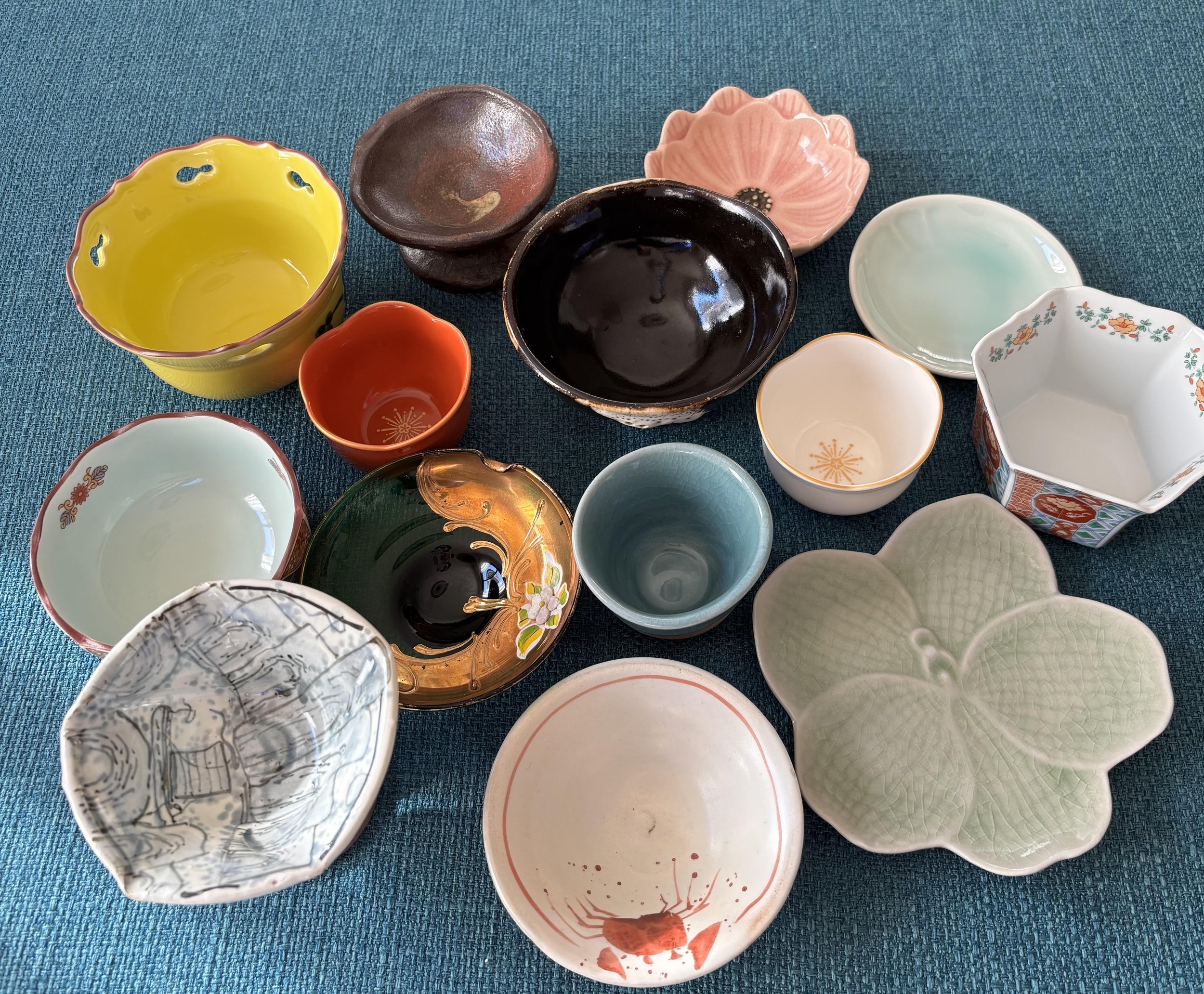Table arrangement using Japanese tableware, known as "Ichiju-Sansai"- Japanese home cooking class in Tokyo
The basic elements of Japanese cuisine are "rice," "miso soup," "grilled fish," and "pickles." Why not incorporate Japanese tableware into this simple meal setting? Beautiful dishes can enrich your daily dining experience.If you don't have Japanese tableware on hand, don't worry. You can still make plenty of arrangements with Western-style dishes. With a little creativity and inspiration, you can add a touch of elegance to your everyday table.Whether you choose Japanese or Western tableware, the most important thing is to enjoy your meal. Through the selection of dishes, let's make our daily dining table more attractive.
Basic Tableware
Rice bowl and soup bowl: Choose complementary pieces and arrange them in a balanced manner.
Medium plate: Select one with horizontal spread for the main dish.
Small plates and tiny dishes: Arrange to fill gaps and create a luxurious impression.
Small bowls: Use distinctive shapes like gourds to add a light atmosphere.
Simple Tips for Table Setting
Consider overall balance by combining dishes of different shapes and sizes.
Be mindful of color balance, incorporating 3 out of 5 colors: red, yellow, green (blue), white, and black for cohesion.
Add playfulness with seasonal chopstick rests and small items.
Use trays to unify the table setting and create a sense of unity.
Side plates- Japanese home cooking class in Tokyo
Characteristics of Japanese Table Setting
Japanese table settings use multiple small plates and bowls for individual servings. This highlights the contrast between dishes and emphasizes the visual appeal of the meal.By refining table settings, you can create a visually satisfying dining experience. Leveraging the characteristics of Japanese tableware while adding modern arrangements can produce a more attractive table.Traditional Japanese table setting follows the "ichiju-sansai" (one soup, three side dishes) arrangement.
Basic Arrangement
The basic arrangement of Japanese tableware is as follows:
Ichiju-sansai (一汁三菜)- Japanese home cooking class in Tokyo
・Dried horse mackerel: "dried horse mackerel" or "dried Aji fish"
・Natto: "natto" (fermented soybeans)
・Pickled daikon radish: "pickled daikon radish"
・White rice: "steamed white rice"
・Miso soup
Chopsticks: Placed on the left using a chopstick rest, with tips pointing to the right.
Rice bowl: Positioned on the left
Soup bowl: Positioned on the right
Main dish (grilled fish or meat): Upper right
Side dish (simmered dish): Upper left
Additional side dish: Center
Reasons for this arrangement:
Left-side prominence tradition: Influenced by Shinto, important or revered items are placed on the left.
Right-handed convenience: Arranged for ease of use by the right-handed majority.
Remembering this basic arrangement allows for appropriate Japanese table setting from everyday meals to special occasions.Points for Selecting Tableware
Color: Choose subdued colors
Material: Wooden soup bowls and natural white dishes (e.g., kohiki) are recommended.
Shape: Combine different shapes to create a vibrant table setting.
Small plates- Japanese home cooking class in Tokyo
Plate Color and Food Compatibility
The color of plates significantly affects the visual appeal and taste impression of food. Here's a detailed explanation of main colors, their effects, and compatibility with dishes:White Plates
Most standard and versatile color.
Highlights the food as the main focus.
Increases perceived sweetness by about 10%, making it especially suitable for desserts.
Gives a light impression, allowing the food to be the star even with fewer items.
Black Plates
Adds a sense of luxury to dishes.
Creates clear contrast, making food appear vibrant.
However, should be avoided for raw fish dishes like sashimi.
Blue Plates
Especially dark blue emphasizes contrast, highlighting the food.
Light blue complements cold dishes and enhances yellow foods (e.g., corn soup).
Caution: May potentially reduce appetite.
Green Plates
Naturally blends with many dishes, acting as a background.
Particularly good with sashimi, suitable for Japanese cuisine presentation.
Easy on the eyes and enhances the beauty of dishes.
Red/Orange Plates
Creates a vibrant impression, but strong red may suppress appetite.
Lighter reds or pinks are more versatile.
Gray Plates
Compatible with various food colors, especially enhancing green, red, and yellow dishes.
Provides an elegant and calm impression while accentuating food colors.
Wooden Plates
Creates a gentle and warm atmosphere.
Suitable for café-style presentations.
Plate color selection should consider the type and color of food, serving occasion, and desired impression. Combining multiple colors and shapes of plates can create a more attractive table setting.
TOMOKITA's Methods to Enhance Japanese Table Settings
A Day in my Washoku cooking class - Japanese home cooking class in Tokyo
Use of small dishes: Arrange many small dishes to create abundance and vibrancy.
Color coordination:
For subdued-colored dishes, use plates with vivid accent colors for contrast.
Coordinate colors with seasons (e.g., pastels for spring, earth tones for autumn).
Textured tableware: Choose items with texture (ceramics, lacquerware, glass) to add warmth to the refined atmosphere of Japanese cuisine.
Seasonal touches:
Express seasonality through small items like chopstick rests.
Incorporate seasonal flowers for a sense of the four seasons.
Create depth: Stack two plates of different sizes for an elegant, three-dimensional effect.
Accent items: Place one eye-catching item (main dish container, seasonal flower, or elaborate glass) to increase overall vibrancy.
Use table centers, trays, or placemats: These create unity even with varied dish sizes and shapes, improving overall impression.
Combining these methods can add more vibrancy and appeal to Japanese table settings.
Please book from here.



